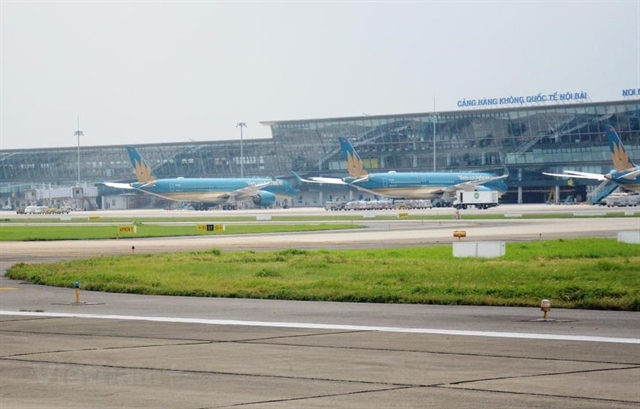 Society
Society


|
| Aeroplanes at the Nội Bài International Airport in Hà Nội. Five proposals of building local airports in five localities have been rejected. — VNA/VNS Photo |
HÀ NỘI — The Civil Aviation Authority of Vietnam (CAAV) has rejected proposals from five localities to build their own airports.
In the report on the evaluation of airport planning submitted to the Ministry of Transport in early May, the CAAV suggested keeping the current number of airports, both planned for construction and fully operational, of 28 by 2030 and adding just one more airport in the northern province of Cao Bằng by 2050.
The proposals for building five airports in the northern provinces of Bắc Giang, Hà Giang, Ninh Bình, central Hà Tĩnh Province and southern Bình Phước Province were rejected.
Nguyễn Anh Dũng, deputy head of the Transport Ministry’s Department of Planning and Investment told local media that there were six main criteria for airport construction.
They included the future forecast demand for passenger volume, evaluating its role in promoting socio-economic development, ensuring national defence and security, emergency relief, natural conditions and access to a city centre. Of these, the demand for passenger volume and natural conditions were the most important criteria.
Dũng said that all airports with annual traffic of fewer than 2 million passengers are facing losses.
In addition, according to international experience, the distance between two airports should be more than 100 kilometres, or it would likely be ineffective, he said.
PhD Nguyễn Bách Tùng, an aviation expert, said the locations of airports were not suitable to the topography.
Tùng cited Hà Giang and Ninh Bình as examples. Hà Giang, with its hilly and mountainous terrain, was not suitable to build an airport while Ninh Bình had large rice fields, which would cause impacts on local people’s livelihood in the land acquisition process.
Tùng also said the majority of domestic airports currently did not reach designed capacity. Some airports often had few passengers in the early stages such as Vân Đồn and Cần Thơ.
Therefore, the efficiency of airport investment should be carefully considered.
Phạm Văn Tới, vice chairman of Vietnam Association of Aviation Science and Technology, said many proposals for airport construction have not been fully surveyed and considered.
For example, Hà Giang proposed an airport for both military and civil purposes, but its land and airspace was limited.
In the report, the CAAV has asked the ministry to keep the planning for Hải Phòng international airport in Tiên Lãng District to be a subsitute for Nội Bài and Cát Bi airports by 2050.
Tới said Tiên Lãng District had a land fund of 4,000 to 6,000 hectares, ensuring the construction of an airport with a capacity of more than 100 million passengers per year. Most of the land was alluvial ground between the Thái Bình and Văn Úc rivers, so it was convenient for site clearance as it would not affect locals’ livelihood.
However, foundation construction would be complicated and costly.
He said Tiên Lãng was a good location as the highways connected it to Hà Nội, making travel more convenient.
He also added that the existing Cát Bi Airport could not be expanded as it was located near a river.
In the report on airport planning, the CAAV proposed the country would have 29 airports by 2050, including 14 international and 15 domestic airports.
Currently, Việt Nam has 22 airports operating nationwide. — VNS




